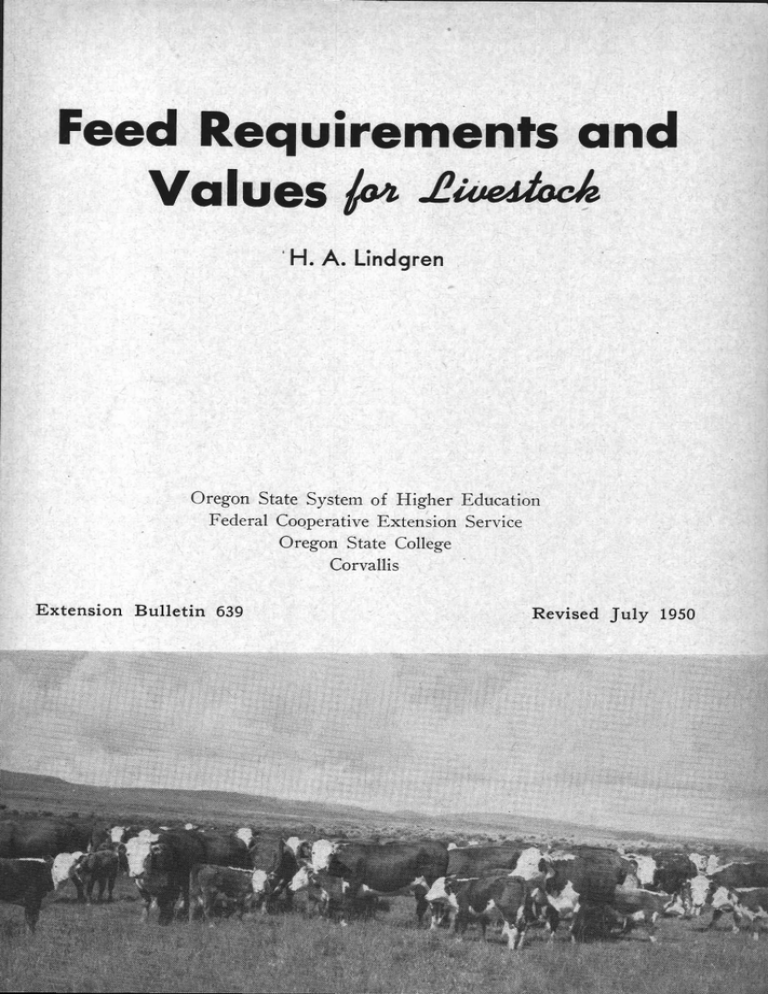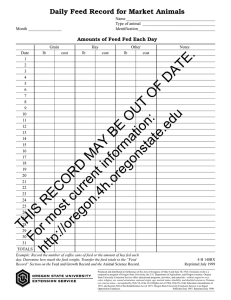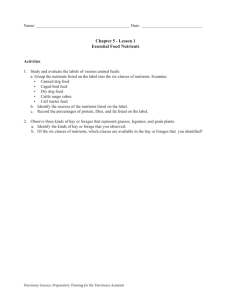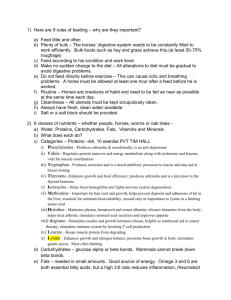Feed Requirements and Values ja4 -2i0e410z4 H. A. Lindgren Extension Bulletin 639
advertisement

Feed Requirements and Values ja4 -2i0e410z4 H. A. Lindgren Oregon State System of Higher Education Federal Cooperative Extension Service Oregon State College Corvallis Extension Bulletin 639 Revised July 1950 Feed Requirements and Values 04 .Eivedleck s..99,44.00,4 04 %/dew's Cia440.4 6,/e900%) H. A. LINDGREN Extension Animal Husbandman successful livestock operator is thoroughly familiar with the THE feed requirements for the animals carried on his holdings and under his conditions. He plans his operations so that he has on the ranch in the fall a safe margin of feed over and above the require- ments for livestock on hand as insurance against unusual weather conditions or short crops the year following. He realizes that there is more profit in keeping 10 per cent fewer animals adequately fed than to have 10 per cent too many and poorly fed. In this bulletin the needs for the different classes of animals are reviewed with the idea of aiding readers not thoroughly familiar with feed requirements. The relative values of different feeds are also discussed. This information is based on data of the Agricultural Experiment Station and the results obtained by practical stockmen. Feed Requirements for Cattle While grass is still plentiful is the time of the year to take inventory of feed and cattle numbers. No more cattle should be kept than can be properly wintered. Hay can usually be purchased to better advantage in the late summer and early fall. Prior to the start of winter feeding it is a good plan to sort the cattle into groups of animals uniform in size and strength. The weaker animals will have a better chance apart from the younger, stronger cattle. Beef cattle The average amount of hay consumed annually by beef cattle in Oregon over a period of years is tons for each animal in the herd. Younger animals consume less and mature animals more than this amount. In sections of the state, particularly the higher elevations where winter conditions are likely to be more severe, the average operator feeds U. tons or more of hay per head. In the milder climate sections the amount fed is approximately 1 ton per animal in the herd. In addition to hay actually fed in a normal year, the operator attempts to have from 25 to 50 per cent hay left to carry over for next year's use. 4 EXTENSION BULLETIN 639 Cows and heifers Save choice hay for breeding cows. Cows and heifers that are to calve should be given the best feeds available. Experimental results indicate that cows should be given sufficient feed to gain 100 to 150 pounds to offset calving loss. Cows fleshy in the fall may lose some body weight during the winter without harm. Thin cows will produce as large calves at birth as fleshy cows, but unless provided with sufficient feed will not produce enough milk to develop the calf. "Calvy heifers" should be fed liberally to prevent loss in weight. They require feed for their own growth as well as for developing a calf. Calves Avoid stunting calves. Weaner calves must be supplied with liberal amounts of feed; otherwise they become stunted and do not recover. They should receive hay equally as choice as the breeding COWS. Steers Steers will winter on less feed in proportion to their weight than cows, heifers, or calves. They should be fed so that they do not lose weight, however, and are thrifty when turned out on grass in the spring. Feed Values for Cattle In considering feedsespecially haysthe stockman is governed by the cost, the amount necessary to carry the animal through the winter, and the availability. In feeding hay to cattle and sheep there is less waste when it is run through a cutter. As a means of saving hay, this practice is recommended. The cost of cutting is offset by the lessened waste. Efficient feeders will save time and feed. When feeding hays, chopping will lessen waste and thus allow wintering of additional livestock. FEED REQUIREMENTS AND VALUES FOR LIVESTOCK 5 Alfalfa hay Alfalfa is a standard hay. Alfalfa provides within itself the nutrients to supply the needs of the animal and also contains important vitamins. It is valuable to combine with other roughages to improve the ration. A few pounds of alfalfa daily, mixed with lowgrade hays, are often desirable, especially for breeding cows. Oat hay Oat hay in many instances has proved equal to or even better than alfalfa. This, of course, depends on the manner in which it has been harvested. Wheat hay Wheat hay of good quality compares favorably with oat hay. Short straw and well-filled heads add to its value. This hay, if cut before it is too ripe or in the soft dough stage, is most desirable. Hay from wheat without beards is best. Barley hay Barley hay from a beardless variety is equal to oat hay in value and is very palatable when cut in the soft dough stage. If cut too late, beards may cause sore mouths. Rye hay Rye hay is coarse but nutritious. Rye hay is used extensively in some sections of eastern Oregon. It is less palatable than other grain -hays because of its coarse stems. Cattle will winter on it, however, when no other hays are available. Grass hays Grass hays give good results. In many eastern Oregon counties, they are considered equal to alfalfa from the standpoint of wintering cattle: This is especially true when the hay contains some clover. Grain straw Straw from small grains is satisfactory. Straw is usually available in many eastern Oregon counties, and can be used in the wintering ration in combination with other feeds. A ration of 5 pounds or more of alfalfa per day with all the good straw she will eat affords a satisfactory ration and will maintain a beef cow in ordinary condition. It has been found that 500 pounds of alfalfa and 1,500 pounds of straw wintered a cow without loss of weight. It is necessary to feed the alfalfa at the same place that straw is fed, otherwise cows will refuse the straw. EXTENSION BULLETIN 639 6 Combine chaff Combine chaff is valuable. This is a product gathered from wheat fields and is the wheat chaff separated from the straw. The ranchers of the Wheat Belt find that this is valuable feed as it contains considerable grain. It is often successfully used alone, although it would be improved with the addition of a few pounds of alfalfa hay or 1 pound of soybean or cottonseed cake per head daily. Small grains Wheat, oats, and barley should be coarsely ground for cattle. Where hay supply is short, 2 pounds of grain per day with all the good, bright straw the cows will eat will keep them from losing in weight. Frosted or shriveled wheat is equal to good wheat in feeding value and usually can be bought for less. Rye is a strong feed but is less palatable than other grains. Mill feed, bran, and shorts mixed, when available, can be used successfully in rations for beef cows. It is about 85 per cent as valuable as wheat and can be fed at the rate of 2 to 3 pounds daily to replace a part of the hay. Small grains and mill feeds, fed in small amounts, will reduce hay requirements at the rate of about 3 pounds for each pound of grain fed. Grain can replace one-third of the hay requirement. - Feed value comparisons 1 pound grain equals 2 pounds alfalfa hay. 1 pound molasses equals 1 pound grain. 1 pound cottonseed or soybean cake equals 3 pounds alfalfa. Feed Requirements for Sheep The average amount of hay consumed by Oregon sheep is 285 pounds. As in the case of cattle, the amount varies in the different parts of the state. Some sections feed as much as 350 pounds per ewe, while other sections where some grazing is available will get through the winter on as little as 150 pounds of hay per animal. Lambing ewes The sheepman should reserve his best hay for lambing as that is the critical period for the ewe. She must be prepared to give enough milk for the lamb ; otherwise the year's efforts may result in loss to the sheepman. This is especially true where lambing is done in sheds. If lambing occurs on good grass, the ewes require less hay to keep up the milk flow. FEED REQUIREMENTS AND VALUES FOR LIVESTOCK 7 If ewes come in from summer range in good condition and satisfactory fall and winter range is available, wintering is a simple problem. On the other hand, if the ewes are thin it takes careful at- tention to build them up in good condition for lambing time. Feed for wool, lamb, and maintenance. A ewe carrying a lamb must have sufficient feed to develop the lamb as well as grow a fleece of wool and maintain her body in weight. Ewes on hay require about 31 pounds daily or its equivalent. Ewes, unlike fleshy cows, "cannot be maintained on straw. When grain hays are used a variety is desirable. Some of the grain hays alone do not carry the necessary balance to supply the pregnant ewe's needs. This, however, will depend on the hay. Prior to lambing, liberal feeding is desirable for 3 or 4 weeks. This insures an ample milk flow, so necessary for the lamb when dropped. -A ewe during pregnancy should gain 6 pounds per month. Developing lambs Ewe lambs need 3 pounds of good, bright hay daily to insure proper development. The ewe lamb has only its growth and wool to maintain hence requires somewhat less feed than the pregnant ewe. Ewe lambs will get along satisfactorily on good winter range without other feeds. A poorly developed lamb will not make a profitable ewe. Feed Values for Sheep Alfalfa hay - . , Alfalfa hay is the standard sheep feed in eastern Oregon and if animals are in good condition at the beginning of the winter they can be maintained on alfalfa alone with excellent results. Sheep can be wintered on grass, grain, and legume hays, grains, silage, and waste potatoes. Bearded hays may cause sore mouths in sheep. e . 4 '-.^sr ° 8 EXTENSION BULLETIN 639 Grass hays Oregon grass hays are satisfactory for ewes if of high quality, although they will not give as good results as alfalfa. If grass hays are of low quality, it is wise to add pound of grain daily to the ration or feed some alfalfa. Grain hays Hay from such grains as oats, wheat, or bald barley will maintain the ewes on 3,1 pounds per day ; however, experiments indicate that a high percentage of the lambs dropped will be weak. For that reason when grain hays are fed, better results will be obtained if grass hay or alfalfa, bright green in color, is substituted for a part of the ration. Bearded varieties of wheat or barley are not advised for sheep as they cause sore mouths. Where bearded grain hays are fed, the hay should be cut and harvested before the beards harden. Grain straw Grain straw is not satisfactory for sheep. Straw from small grains is not considered adequate for ewes carrying lambs. Numerous experiments in the western states have shown a high percentage of weak lambs and heavy lamb losses where straw was used as the sole roughage. Combine chaff Combine chaff is being used in Oregon wheat counties for wintering ewes. It contains some grain and is therefore more valuable than straw. Its quality may vary somewhat. Judgment should be exercised in using this feed. Silage and waste potatoes Ewes respond in milk flow very favorably when some succulent feed is supplied. Most common feeds for this purpose in Oregon are silage and waste potatoes. A pound of silage daily in the ration stimulates milk flow. Potatoes are fed by many of the successful operators in the state. They can be fed whole. One to two pounds daily with the hay is sufficient. . Feed Requirements for Swine It will require 950 pounds of grain or its equivalent to carry a sow from the time she is bred until the litter is weaned. It will require 710 pounds of grain or its equivalent to carry a 30-pound weaner pig to the weight of a 200-pound market hog. FEED REQUIREMENTS AND VALUES FOR LIVESTOCK 9 Feed Values for Swine Concentrates Properly to balance a ration for swine, protein concentrates such as tankage or fish meal are needed. Pigs on pasture would thrive much better, however, if they could be provided with a mixture made up of 5 pounds of those products with 95 pounds of grain. If animal proteins are not available the oil meal products can be used. Fifty per cent more of the oil meal products than of tankage or fish meal will be required. Pasture Pasture will reduce the grain requirement for growing and fattening pigs by one-fourth or more. Potatoes, cull fruits, and vegetables Potatoes, cull fruits, and vegetables are satisfactory for hog feed when fed with grain. Fruits and vegetables are fed raw. It pays to steam the potatoes. Four hundred pounds of steamed potatoes will replace 100 pounds of grain. Best results are obtained in feeding potatoes if 100 pounds of ground grain are added to each 400 pounds after they have cooled. Potatoes should be heated only sufficiently to crack the skins. Two pounds of salt added to each 100 pounds of potatoes will add to the palataility. The salt water in the bottom of the vat should be discarded. Minerals Minerals are essential in the hog lot in view of the shortage of minerals in the feeds commonly fed to hogs. Steamed bone flour, ground limestone, and salt, equal parts, supply the necessary minerals. Pasturing will reduce grain requirements for hogs. Cull fruits and vegetables may be fed. Minerals and protein concentrates are needed. MI* EXTENSION BULLETIN 639 10 Other Feeds Concentrates - Concentrates can be used satisfactorily to save hay as well as to improve the ration for feeding sheep. It has been found experimentally that 1 pound of grain replaces 2 pounds of hay. Oats, wheat, and barley are most satisfactory. Rye is a strong feed but less palatable and must be used with judgment. Some eastern Oregon operators have used cottonseed cake to some extent in the past where there has been a shortage of hay and where it is necessary to transport the feed long distances. Soybean cake can be fed and stored in the same way as cottonseed cake. Soybean cake contains slightly more and higher quality protein than that found in cottonseed cake. Soybean cake is as palatable as the other product. It has been found wise to limit the amount per animal to slightly less than cottonseed cake as it is more laxative. The amount of cake usually fed to livestock is as follows : cattle-1 to 11 pounds per head daily ; sheepf, to pound daily. : As indicated in this discussion, these high protein concentrates are valuable where low protein hays and straw are fed. Crop residues Oregon produces a large acreage of seed crops. The residue in the form of straw from these crops amounts to one-half million tons annually. A considerable quantity of this is being used by livestock growers for feed, while a large part of it is burned in the field. It is understood, of course, that the value of these residues depends largely on palatability. The palatability is greatly increased if the residue can be saved in a form containing as much of the leaf growth as possible; also it should contain green color. These residue products contain somewhat less protein than hays, but if palatable are very satisfactory in the ration for wintering. The residue crops include alfalfa, clovers, vetch, peas, and grasses after seed has been threshed. In localities where there is a shortage of feed an effort should be made to conserve these residue crops in the best possible form. Often the palatability of these products can be increased through the use of molasses. Wintering trials at the Eastern Oregon Branch Experiment Station showed that cattle could be brought through the winter in reasonably good condition on grain straw and 1 to 2 pounds of oil cake daily. Straws from legumes and grasses contain more food value than grain straw. Cooperative Extension Work in Agriculture and Home Economics Wm. A. Schoenfeld, Director Oregon State College and United States Department of Agriculture, Cooperating Printed and distributed in furtherance of the Acts of Congress of May 8 and June 30, 1914





